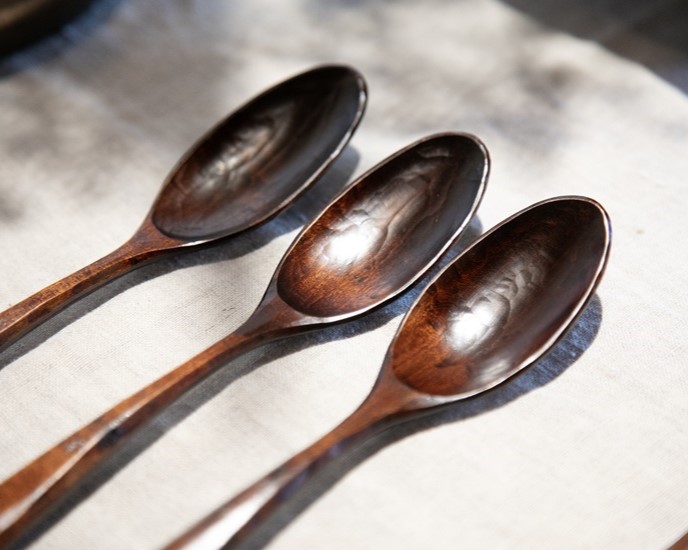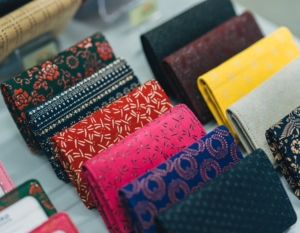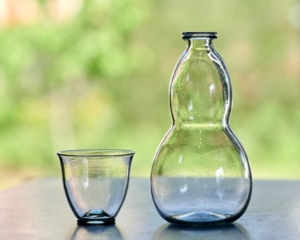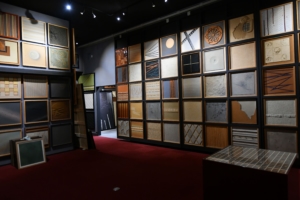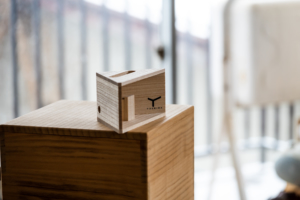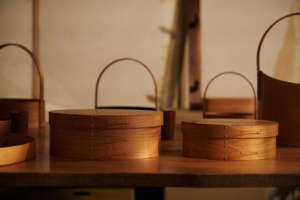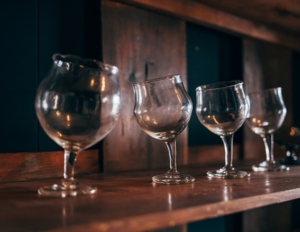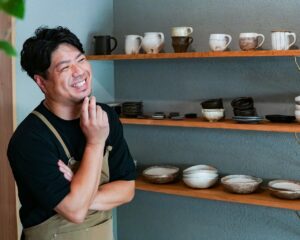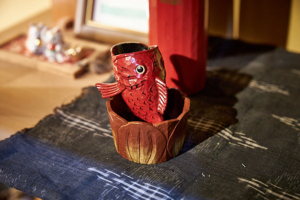In a small port town facing the Seto Inland Sea, woodworker Atsushi Sakai has been diligently making wooden spoons all by himself. In his workshop, he produces a wide variety of warm and welcoming works, from spoons that serve as tools to spoons that look like works of art.
To the spoon shop as if guided.

Ushimado Town in Setouchi City is located in the southeastern part of Okayama Prefecture, facing the calm Seto Inland Sea. It is a port town with a prosperous history as a port of call for Kitamae ships and diplomatic missions from Korea, the Korean Envoys to Japan, during the Edo period. On a street that retains its old townscape, Atsushi Sakai has his workshop, “Spoon Shop. Across the street, his wife, Kayo, runs the “sajiiya studio,” a gallery store that sells Sakai’s works and holds special exhibitions.
After graduating from college, Mr. Sakai worked for a company in Tokyo for about two years. However, he felt that this life was not for him. When he thought again about what he wanted to do, the thought that came to his mind was “I want to live by making things. Then, in 1994, with the encouragement of his wife, he started making woodwork on his own. At first, he worked on signboards, doorplates, chairs, and other items ordered by acquaintances. Eventually, he was asked, “If you’re whittling wood, why don’t you make spoons?” or “If it’s a spoon, why don’t you paint it with lacquer? He met people who gave him advice at every step of the way, such as “If you are cutting wood, why don’t you make spoons? As he was guided by these words, he found that the items he was working on were concentrated on wooden spoons.
Therefore, around 2000, he decided to change the name of his shop to Spoon Shop and specialize in making wooden spoons. At that time, handmade artist’s tableware was beginning to attract attention at galleries and stores. Demand for wooden spoons to go with these vessels was also on the rise. As if to ride the current trend, he devoted himself to spoon making, and in 2006, opened a store and workshop in Kunitachi City, Tokyo.
If I don’t focus on what I create.

The turning point was the Great East Japan Earthquake in 2011. He asked himself what he could do to continue making things no matter what, and decided to move to Okayama Prefecture. He decided to move to Okayama Prefecture because he had friends there and because it was a place where craftsmanship had taken root. Local people say there is nothing in the area, but I felt a vague potential in the serene environment. In August 2013, he moved to Ushimado Town in Setouchi City.
This was the beginning of a change in Mr. Sakai’s craftsmanship. In Tokyo, his cycle of activities consisted of producing spoons for exhibitions. In the process, he found himself focusing on the content of the exhibition and the appearance of the spoons. I realized that I needed to focus more on the spoon I was making,” Sakai recalls. He reexamined what materials he was using, what tools he was making them with, and to whom he wanted to deliver them, and from then on, making things at his own pace became the basis of his work.
I still have a hard time deciding where to stop cutting.

In his one-man workshop, there are various pieces of wood and branches of various sizes, as well as a variety of tools. Some of the tools are self-made, based on those used by shoemakers in Europe. Using these tools, he first carves out the rough shape of a spoon from a piece of wood. No matter how skilled he is, he cannot resist the grain of the wood, so he always works with the grain in mind. Finally, he uses a knife to shave off the hollows to form the shape of the spoon. Mr. Sakai says that he is still searching for the right place to complete his work. His words seem to show how sincerely he has been working on each and every spoon.
Spoons in three categories

Currently, Mr. Sakai’s spoons can be broadly classified into three categories. The first is standard products for daily use. The main material used is cherry wood, which is easy to work with and durable. To make the spoons smooth to the touch, he repeatedly coats them with lacquer and wipes them clean. The spoon is a delicate tool to put in the mouth. Moreover, a wide range of people use spoons in their daily lives, from babies in the weaning stage to the elderly who find metal spoons heavy and cold.
While valuing the pleasant feeling in the mouth that only wood can provide, we also pay attention to the functionality of the spoon as a tool. Through repeated trial and error, we arrived at the current shape, which is both pleasing to the eye and comfortable to use.
And 25 different sizes are available. Mr. Sakai smiles gently and says, “I have increased the number of spoon sizes to meet the needs of users and their purposes. The series is also maintenance-friendly, and is filled with Sakai’s pride in the spoon as a tool.
Make without excess, and make the most of the wood.

The second category is a series of products made from thinned wood, which he started after moving to the area. For the standard spoons mentioned above, he uses wood purchased from a fine wood store as a material, but only a small portion is used for the spoons. For many years, he had felt a sense of regret about using only a small portion of the wood for his spoons.
For the thinned wood spoons, he looks at the wood and carves out a usable spoon shape. From the remaining blank space, a small butter knife is made. Rather than wasteful, the craftsman’s approach is based on the perspective of what can be done with the wood without wasting it. Furthermore, this series of knives are not lacquered so that they can be used and enjoyed with the eyes as they change over time.
The third is a series of works of art made from thinned olive wood, a specialty of Ushimado, which has been developed under the name “Shobokushi” since 2018. The process of making them is unique. He says, “I look at the shape of the branch and forcefully apply the shape of a spoon to it. By doing so, the unusual shape of the tree branch, the color of the bark, and the fibers of the wood are brought to life. I make this product because I want to feel the exquisiteness of wood. They are not easy to use as tools, but they are interesting to make.
Our goal is to keep making them for a long time.

About 25 years ago, at the age of 30, Mr. Sakai decided to become a spoon shop owner. He has no regrets about that decision. Thanks to that decision, I have been able to travel to many places and meet many people. Every day, he feels the connection between himself and the world through the medium of wooden spoons.
In 2023, he started a spoon-making club called “spoon club 4U,” which meets monthly at his workshop. It is not a one-way class where Mr. Sakai teaches, but a club where everyone spoon-makes together. The fact that he has met people here who are interested in making spoons has also been a stimulus for his creations.
When asked about their goals for the future, they responded with two answers, one large and one small. The smallest goal is to make small wooden bowls and develop them as a set with a spoon. Toward that goal, he is practicing making bowls little by little. His big goal is to continue making spoons for as long as possible. We wonder what kind of world Mr. Sakai, who has been devotedly working with spoons, will show us in the future.



